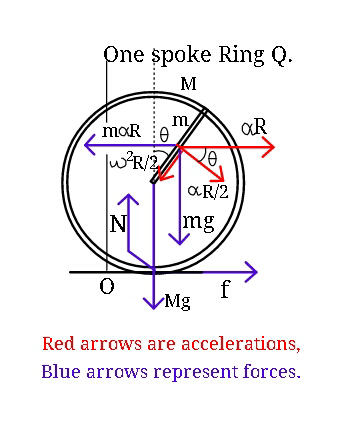Question Number 23472 by ajfour last updated on 31/Oct/17

Commented by ajfour last updated on 31/Oct/17

$${Q}.\mathrm{23390}\:\left({continued}..\right) \\ $$
Answered by ajfour last updated on 31/Oct/17
![Applying ΣF_x =Σma_x from the ground frame: f=(M+m)(αR)+((m(αR)cos θ)/2) −mω^2 ((R/2))sin θ ...(i) Applying Στ = I_(net) α from the frame of centre of ring: ((mgRsin θ)/2)−fR−(mαR)((R/2)cos θ) =(MR^2 +((mR^2 )/3))α ...(ii) eliminating f from (i) and (ii): ((mgsin θ)/2)−(M+m)(αR) −((m(αR)cos θ)/2)+((mω^2 Rsin θ)/2) −((m(αR)cos θ)/2) =(M+(m/3))(αR) ⇒ (αR)[M+(m/3)+M+m+mcos θ] =((msin θ)/2)(ω^2 R+g) ⇒ α=((m(ω^2 +g/R)sin θ)/(2[2M+((4m)/3)+mcos θ])) ⇒ ((ωdω)/dθ) =((m(ω^2 +(g/R))sin θ)/(2[2M+((4m)/3)+mcos θ])) ∫_0 ^( ω) ((2ωdω)/(ω^2 +(g/R))) = ∫_0 ^( θ) ((msin θ)/(2M+((4m)/3)+mcos θ)) ln (((ω^2 +(g/R))/(g/R)))=ln (((2M+((4m)/3)+m)/(2M+((4m)/3)+mcos θ))) ((ω^2 R)/g)+1 =1−((m(1−cos θ))/(2M+((4m)/3)+mcos θ)) 𝛚^2 =(g/R)(((1−cos 𝛉)/(((2M)/m)+(4/3)+cos 𝛉))) And 𝛂 =(1/2)((d(𝛚^2 ))/d𝛉) . To obtain the time for the return, ⇒ 𝛚= (d𝛉/dt)=(√(g/R))[((1−cos θ)/(b^2 +cos θ))]^(1/2) ⇒ T =4(√(R/g))∫_0 ^( π) [((b^2 +cos θ)/(1−cos θ))]^(1/2) dθ where b^2 =((2M)/m)+(4/3) . .... might continue ...](https://www.tinkutara.com/question/Q23474.png)
$$\:{Applying}\:\Sigma{F}_{{x}} =\Sigma{ma}_{{x}} {from}\:{the} \\ $$$${ground}\:{frame}: \\ $$$$\:\:{f}=\left({M}+{m}\right)\left(\alpha{R}\right)+\frac{{m}\left(\alpha{R}\right)\mathrm{cos}\:\theta}{\mathrm{2}} \\ $$$$\:\:\:\:\:\:\:\:\:\:\:\:\:\:\:\:\:\:\:\:\:\:\:\:−{m}\omega^{\mathrm{2}} \left(\frac{{R}}{\mathrm{2}}\right)\mathrm{sin}\:\theta\:\:\:…\left({i}\right) \\ $$$${Applying}\:\Sigma\tau\:=\:{I}_{{net}} \alpha\:{from}\:{the} \\ $$$${frame}\:{of}\:{centre}\:{of}\:{ring}: \\ $$$$\frac{{mgR}\mathrm{sin}\:\theta}{\mathrm{2}}−{fR}−\left({m}\alpha{R}\right)\left(\frac{{R}}{\mathrm{2}}\mathrm{cos}\:\theta\right) \\ $$$$\:\:\:\:\:\:\:\:\:\:\:\:\:\:=\left({MR}^{\mathrm{2}} +\frac{{mR}^{\mathrm{2}} }{\mathrm{3}}\right)\alpha\:\:\:…\left({ii}\right) \\ $$$${eliminating}\:\boldsymbol{{f}}\:{from}\:\left({i}\right)\:{and}\:\left({ii}\right): \\ $$$$\frac{{mg}\mathrm{sin}\:\theta}{\mathrm{2}}−\left({M}+{m}\right)\left(\alpha{R}\right) \\ $$$$−\frac{{m}\left(\alpha{R}\right)\mathrm{cos}\:\theta}{\mathrm{2}}+\frac{{m}\omega^{\mathrm{2}} {R}\mathrm{sin}\:\theta}{\mathrm{2}} \\ $$$$\:\:\:\:−\frac{{m}\left(\alpha{R}\right)\mathrm{cos}\:\theta}{\mathrm{2}}\:=\left({M}+\frac{{m}}{\mathrm{3}}\right)\left(\alpha{R}\right) \\ $$$$\Rightarrow\:\left(\alpha{R}\right)\left[{M}+\frac{{m}}{\mathrm{3}}+{M}+{m}+{m}\mathrm{cos}\:\theta\right] \\ $$$$\:\:\:\:\:\:\:\:\:\:\:\:\:=\frac{{m}\mathrm{sin}\:\theta}{\mathrm{2}}\left(\omega^{\mathrm{2}} {R}+{g}\right) \\ $$$$\Rightarrow\:\:\alpha=\frac{{m}\left(\omega^{\mathrm{2}} +{g}/{R}\right)\mathrm{sin}\:\theta}{\mathrm{2}\left[\mathrm{2}{M}+\frac{\mathrm{4}{m}}{\mathrm{3}}+{m}\mathrm{cos}\:\theta\right]} \\ $$$$\Rightarrow\:\:\frac{\omega{d}\omega}{{d}\theta}\:=\frac{{m}\left(\omega^{\mathrm{2}} +\frac{{g}}{{R}}\right)\mathrm{sin}\:\theta}{\mathrm{2}\left[\mathrm{2}{M}+\frac{\mathrm{4}{m}}{\mathrm{3}}+{m}\mathrm{cos}\:\theta\right]} \\ $$$$\int_{\mathrm{0}} ^{\:\:\omega} \frac{\mathrm{2}\omega{d}\omega}{\omega^{\mathrm{2}} +\frac{{g}}{{R}}}\:=\:\int_{\mathrm{0}} ^{\:\:\theta} \frac{{m}\mathrm{sin}\:\theta}{\mathrm{2}{M}+\frac{\mathrm{4}{m}}{\mathrm{3}}+{m}\mathrm{cos}\:\theta} \\ $$$$\:\mathrm{ln}\:\left(\frac{\omega^{\mathrm{2}} +\frac{{g}}{{R}}}{\frac{{g}}{{R}}}\right)=\mathrm{ln}\:\left(\frac{\mathrm{2}{M}+\frac{\mathrm{4}{m}}{\mathrm{3}}+{m}}{\mathrm{2}{M}+\frac{\mathrm{4}{m}}{\mathrm{3}}+{m}\mathrm{cos}\:\theta}\right) \\ $$$$\frac{\omega^{\mathrm{2}} {R}}{{g}}+\mathrm{1}\:=\mathrm{1}−\frac{{m}\left(\mathrm{1}−\mathrm{cos}\:\theta\right)}{\mathrm{2}{M}+\frac{\mathrm{4}{m}}{\mathrm{3}}+{m}\mathrm{cos}\:\theta} \\ $$$$\:\:\:\:\boldsymbol{\omega}^{\mathrm{2}} \:=\frac{\boldsymbol{{g}}}{\boldsymbol{{R}}}\left(\frac{\mathrm{1}−\mathrm{cos}\:\boldsymbol{\theta}}{\frac{\mathrm{2}\boldsymbol{{M}}}{\boldsymbol{{m}}}+\frac{\mathrm{4}}{\mathrm{3}}+\mathrm{cos}\:\boldsymbol{\theta}}\right) \\ $$$${And}\:\:\:\boldsymbol{\alpha}\:=\frac{\mathrm{1}}{\mathrm{2}}\frac{\boldsymbol{{d}}\left(\boldsymbol{\omega}^{\mathrm{2}} \right)}{\boldsymbol{{d}\theta}}\:. \\ $$$${To}\:{obtain}\:{the}\:{time}\:{for}\:{the}\:{return}, \\ $$$$\Rightarrow\:\boldsymbol{\omega}=\:\frac{\boldsymbol{{d}\theta}}{\boldsymbol{{dt}}}=\sqrt{\frac{{g}}{{R}}}\left[\frac{\mathrm{1}−\mathrm{cos}\:\theta}{{b}^{\mathrm{2}} +\mathrm{cos}\:\theta}\right]^{\mathrm{1}/\mathrm{2}} \\ $$$$\Rightarrow\:{T}\:=\mathrm{4}\sqrt{\frac{{R}}{{g}}}\int_{\mathrm{0}} ^{\:\:\pi} \:\:\left[\frac{{b}^{\mathrm{2}} +\mathrm{cos}\:\theta}{\mathrm{1}−\mathrm{cos}\:\theta}\right]^{\mathrm{1}/\mathrm{2}} {d}\theta \\ $$$$\:\:\:\:{where}\:{b}^{\mathrm{2}} =\frac{\mathrm{2}{M}}{{m}}+\frac{\mathrm{4}}{\mathrm{3}}\:. \\ $$$$\:\:\:….\:{might}\:{continue}\:… \\ $$
Commented by mrW1 last updated on 31/Oct/17

$$\mathrm{how}\:\mathrm{is}\:\mathrm{it}\:\mathrm{to}\:\mathrm{explain},\:\mathrm{that}\:\mathrm{the}\:\mathrm{time}\: \\ $$$$\mathrm{from}\:\theta=\mathrm{0}\:\mathrm{is}\:\mathrm{not}\:\mathrm{convergent}? \\ $$
